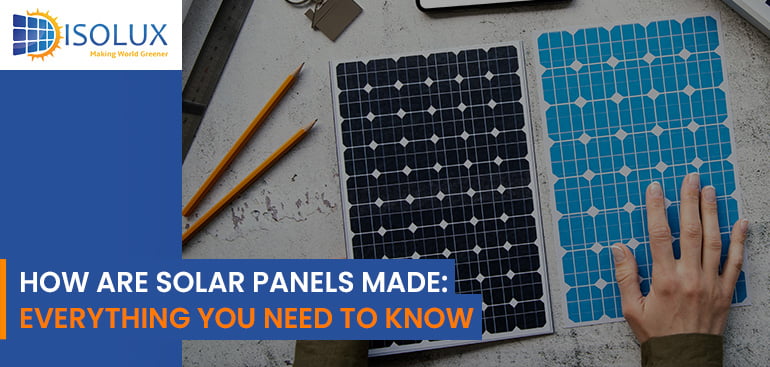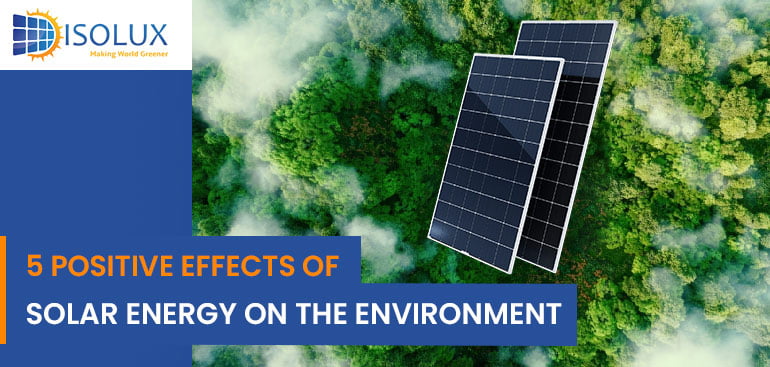Solar panels, which bring us clean energy, are now essential to our effort to live sustainably. As technology advances, the process of creating these solar panels has evolved. Let’s dive into the details of how Solar Panels have made their environmental impact and future trends.
What are Solar Panels?
A crystalline silicon solar panel, by weight, consists of about 76% glass, 10% plastic polymer, 8% aluminum, 5% silicon, 1% copper, and less than 0.1% silver and other metals, according to the Institute for Sustainable Futures. It’s interesting to note that silicon, a key component, is derived from silicon dioxide in beach sand.
Before being utilized in a solar panel, silicon dioxide must undergo a transformation into pure Metallurgical Grade Silicon – MGS. This energy-intensive conversion process requires 14-16 kWh of power to produce 1 kilogram of metallurgical grade silicon—equal to running your home oven for seven hours. But, it’s worth highlighting that, over their lifespan, solar panels emit 25 times less carbon dioxide per kilowatt hour compared to coal-powered electricity.
So, despite the initial energy investment, solar panels prove to be a cleaner and more sustainable energy source in the long run.
How Solar Panels Made
1. Building Solar Cells
Silicon ingots are melted and mixed with gallium or boron to form wafers. Phosphorus is added to give silicon its electrical capability. The silicon is then cut into thin sheets, coated to reduce reflection, and lines are cut into the cells to help the flow of electrical current.
2. Soldering Cells
Solar cells, whether monocrystalline or polycrystalline, are soldered together to form a panel. 60 or 72 solar cells are combined to create one panel.
3. Installing Backsheet
A protective back sheet is installed to shield the bottom of the solar cells.
4. Installing Glass Front
The front of the solar panel is covered with glass. By allowing sunlight to reach the solar cells and providing a protective layer.
5. Sealing in Metal Frame
A metal frame is sealed around the panel using silicon to fuse all layers together.
6. Adding Junction Box
A junction box is installed to protect the solar panel’s electrical wires from damage.
7. Quality Testing
The solar panel undergoes rigorous testing for quality and strength before being shipped out for use.
Technological Advancements
1. Thin-film Solar Panels
Advancements like thin-film technology have revolutionized solar panels, making them more flexible and adaptable to various surfaces.
2. Bifacial Solar Panels
Bifacial solar panels capture sunlight from both sides, enhancing efficiency and power output.
3. Efficiency Improvements
Ongoing research aims to enhance the efficiency of solar panels. By making them more viable for widespread adoption.
Environmental Impact
1. Energy Payback Period
Solar panels have a positive impact on the environment, with the energy payback period decreasing.
2. Recycling Initiatives
Efforts are underway to address the recycling of solar panels. By minimizing their environmental footprint.
Challenges in Solar Panel Production
1. Resource Scarcity
As demand for solar panels rises. Challenges related to the availability of resources, especially high-grade silicon, emerge.
2. Cost Implications
The initial cost of solar panels remains a concern, despite long-term savings on energy bills.
3. Technological Challenges
Innovations bring challenges, and the solar industry grapples with staying ahead of technological advancements.
Future Trends
1. Innovations in Solar Technology
The future promises exciting innovations. Such as advancements in solar paint and transparent panels.
2. Increased Efficiency
Continuous efforts are focused on boosting the efficiency of solar panels. By making them more cost-effective.
3. Integration with Smart Grids
Solar panels will play a crucial role in the development of smart grids, optimizing energy distribution.
Benefits of Solar Panels
1. Clean Energy Production
Solar panels contribute significantly to reducing carbon emissions, providing a cleaner alternative to traditional energy sources.
2. Reduced Carbon Footprint
Adopting solar energy helps individuals and businesses reduce their carbon footprint, contributing to a sustainable future.
3. Economic Advantages
Long-term economic benefits, including reduced energy bills and potential government incentives, make solar panels a wise investment.
Conclusion
Understanding the process behind how solar panels are made not only deepens your appreciation for the technology but also highlights the progress made in sustainable energy. Embracing solar power isn’t just about the end product on your roof; it’s about embracing a brighter, greener future for our planet.
Get a solar panel for your roof from Isolux Solar. Contact us today and get a free quote now!




